18.0 WORKPLACE AND ESTABLISHMENT SURVEYS
Note: Significant components of this chapter come from Tierney et al.’s FHWA Manual Chapter 10. Other key contributors are Frank Southworth, Yongping Zhang and Joy Sharp.
Workplace and establishment surveys are conducted to collect data on the characteristics of trips made to non-residential establishments. The people who go to non-residential, or commercial, establishments can be divided roughly into two classes: workers and visitors. An establishment survey may be directed toward either or both groups, or may concentrate on a specific type of establishment, e.g., shopping center, school, hospital, etc. Many types of analyses, especially those related to studying rezoning, traffic impacts, congestion management, and trip reduction programs, require information on the number and types of trips attracted to various facilities.
The most exacting collection procedures belong to the workplace survey specifically designed for obtaining data needed for the calibration of the trip attraction models. In model development, the trip attraction data are used to help balance the production data collected during a household travel/activity survey, and to provide more detailed origin-destination data for specific types of facilities or for specific geographic locations. Attraction rates, such as person trips per employee by industry type, are commonly sought. Using secondary sources of data, such as State Employment Commission establishment data, it is possible to apply the survey-derived attraction rates to make small area estimates of trip attractions for home-based work trips, home-based non-work trips, and non-home-based trips.
In the past, trip attraction data were obtained from household travel surveys, external vehicle surveys, and commercial vehicle surveys. However, as the focus of household surveys shifted from providing zone-to-zone trip tables (requiring large sample sizes) to providing travel model input data with acceptable precision levels (requiring smaller sample sizes), the trip attraction data became inadequate in many cases. The sampling variability of trip attraction rates based upon small sample household travel surveys is enormous. Providing estimates of home-based work attractions from a household survey requires aggregation across the entire planning region, which masks any variability by geographic location. If, for instance, one wishes to estimate hospital trip generation, it is more helpful to count the arriving trips at a sample of hospitals, rather than estimating the trips to all hospitals in the region by a small sample of households.
In the mid-1980s, planning agencies began to obtain workplace and establishment survey data as part of their regional modeling data collection efforts. Since that time, the increased interest in employer-based TDM measures has led to the implementation of several other workplace and establishment surveys throughout the country.
The workplace/establishment survey can incorporate up to five separate data collection efforts for each sampled workplace:
- Collection of employer information;
- Survey of employees;
- Survey of visitors;
- Person and/or vehicle count; and
- Survey and count of delivery people and/or a count of delivery vehicles.
18.1 Assembly of Background Data
Two types of background information are typically assembled for workplace and establishment surveys:
- Data on employers in the study area; and
- Available information on people’s journeys-to-work.
The key information needed for the design and implementation of work-place/establishment surveys is a comprehensive inventory of establishments within the study area. The survey team needs to develop a database that contains the name, address, and key characteristics of each establishment, such as:
- Number of employees at each site;
- Type of business (usually based on North American Industrial Classification System (NAICS) codes);
- Type of area that the establishment is in (employment density classes or a standard agency classification);
- Name of manager to contact in seeking permission to conduct the survey; and
- Name of manager to work with in implementing the survey.
The primary use of the database is as the sampling frame for the survey; the establishment characteristics that are needed for a particular survey effort will depend on the survey team’s data needs.
- Commercial firms, such as Dun & Bradstreet Information Services, and American Business Information, maintain files of commercial establishments primarily for purposes such as providing data on the credit worthiness of firms and to provide marketing prospects for clients. Some commercial database vendors attempt to maintain establishment databases that contain a great deal of business information for each establishment within a region. For instance, the Dun & Bradstreet database can provide more than 50 data items about each establishment, including:
- Company name;
- Trade name;
- Street address and mailing address;
- Telephone number;
- Total employees;
- Employees on-site;
- Names of key staff;
- Year business was started;
- Line of business;
- Up to six NAICS codes;
- Number of employees three years ago; and
- Number of employees five years ago.
- Dun & Bradstreet updates the establishment database on a continuous basis. The database generally provides a fairly comprehensive listing for larger employers, but is not as reliable for a full listing of small employers because the lifespan of small businesses can be short, and because these businesses are harder to locate. The accuracy of the location of the site and the number of employees must always be verified.
- Each state collects employment and wages data from most establishments for the purposes of administering unemployment insurance. In addition, the states and the federal government maintain current employment data for measuring labor force participation and unemployment. Some state employment divisions will share with planners disaggregate employment data (employment information on an establishment-by-establishment basis) provided that confidentiality considerations are addressed. These state employment databases include the Federal Identification Number, the NAICS code, the number of employees, and an address, usually keyed to where the payroll is prepared. The address must be carefully verified along with the number of employees, since franchises and branch offices are often combined in a listing under one main office. In addition, up to half of the employers list post office boxes as the address of record. Provided that establishment data are available from state sources, these files are usually available to a planning agency or survey team free of charge.
- The Polk Directory is available through many libraries, and offers a rather comprehensive listing of household and employment data sorted by name and address. For business establishments, the address, owner’s name, telephone number, and type of business – including listings for associations, libraries, and organizations which may not be available from state sources – can be determined.
- The telephone directory, which lists the businesses in the area by street address, is a rich source of data because most businesses are listed. However, no information on type of industry or number of employees is available through telephone directories; these data would need to be developed by the survey team.
For 1992, 1997, 2002 and 2007, counts of establishments by detailed NAICS industry by receipt size are available from the U.S. Census Bureau (on the American FactFinder website and on the 2002 Economic Census DVD-ROM). ZIP Business Patterns (ZBP) data from Census also provides counts of establishments by industry by employment size for a broader range of industries than are included in the Economic Census ZIP Code Statistics. ZBP is published generally 2 to 3 years after the end of the reference year, starting 1994.Since the data sources have been compiled for different reasons, none is totally accurate or comprehensive for use in travel surveys. The survey team needs to evaluate the costs and benefits of each data source before selecting the best sampling frame inputs.
Often, a multiple-source data system will provide the survey team with a comprehensive and reliable database which can also be regularly updated. Sometimes, survey teams use State Employment Commission data as a base, and then verify the address and number of employees with the Dun & Bradstreet file for the same area. Telephone calls can be made to settle any differences in data between the two sources, and to verify certain data.
Once the employer database has complete data for the base year, updates can be made by simply using updated state data and matching the Federal Identification Number to update the number of employees.
Non-matches in the original file are establishments that have gone out of business, and non-matches in the new state file are new businesses (which must be verified as to location and number of employees). If the survey team has the capability to store the establishment data in a GIS database, then the verification and updating of information is greatly facilitated. In addition, this data format allows survey team members and agency staff to conduct field checks of establishments to ensure that the database matches actual conditions.
In addition to assembling the establishment data, the survey team will usually benefit from analyzing the Census Journey-to-Work data. These data will help define the likely range of responses to survey questions at given locations. For instance, the Census data will tell the survey team whether transit is a viable access mode for a particular location. The survey team can then customize response categories to reflect this information. The Journey-to-Work data can also help verify the data on the number of employees at establishments within counties, county sub-divisions, and traffic analysis zones. The Census Journey-to-Work data are discussed briefly in Appendix B.
18.2 Survey Design
The survey team faces several survey design issues with regard to workplace and establishment surveys, including:
- What is the relevant survey population, employees and visitors or employees only?
- What survey method(s) should be used?
- Given the chosen survey method, what data collection techniques should be employed?
- What accuracy-enhancing (bias-reducing) measures should be used?
These four issues are described below.
Survey Population
Based on the survey data needs, the survey team must determine the relevant population for the workplace and establishment survey. For most modeling analyses, survey teams will be interested in obtaining information about trips to and from the establishment, regardless of whether they are made by employees or visitors to the establishment. This information is needed for developing trip attraction rates. However, for some analyses, especially those related to potential employer-based transportation demand management (TDM) measures, the most appropriate survey population includes only on-site employees. This decision about the survey population guides the selection of survey methods and techniques, and the organization and fielding of the survey.
A second survey population decision for the survey team that is interested in collecting both employee and visitor information is the determination of how commercial trips and freight movements to and from the site should be considered. Sometimes, if the workplace survey is being conducted in conjunction with a commercial vehicle survey, it is easier to leave commercial trips out of the workplace survey population. On the other hand, it is not always possible to distinguish these trips from visitor trips, and by not considering these trips, the survey team loses some potentially useful data.
Survey Methods for the Workplace/Establishment Survey
Three general survey methods for conducting workplace/establishment surveys are used. Since there is really only one way to identify and sample the universe of visitors to the establishment, the methods differ only in how employees are surveyed. In the first approach, the employee and visitor surveys are conducted together by intercepting a random sample of all people entering and/or leaving an establishment. The second method involves implementing only a centralized employee survey. No data are collected from visitors. In the third method, visitors are intercepted as they enter and/or leave the establishment, but employees are surveyed separately through some centralized means, such as an employer-distributed self-administered mailback survey. Each method requires a small amount of information to be gathered from the employer, such as survey day employee attendance, and information on any special activities occurring during the survey period.
Tables 18.1 through 18.3 summarize the different survey methods.
The two methods that have a personal intercept component require counts of people entering and/or leaving the establishment to be conducted for weighting purposes and for trip attraction calculation. The counts are the most important aspect of many workplace surveys. An accurate count of persons entering and/or leaving the workplace allows for the calculation of attraction rates for that establishment. Without an accurate count, no rate calculations are possible. This is stressed because no other activity at the site should be allowed to interfere with the accuracy of the counts.
Two methods for counting people can be used. First, fieldworkers can be asked both to count (and record) people and administer the survey. This is feasible if fieldworkers are simply handing out self-administered survey forms, especially for lower volume entrances or times of day. The second method for counting is to assign multiple fieldworkers to each entrance, one of whom simply counts people while the others administer the survey. This method is desirable for very busy entrances and for surveys in which personal interviews are to be conducted. If multiple entrances to the workplace exist, an accurate count is needed of each. If an entrance is not visible from the counter’s location, an additional counter should be assigned. If the arrival rate is too high for a single counter to achieve an accurate count, additional counters should be scheduled. When more than one counter is used for a high-volume area, they should work back-to-back if possible, to lessen the chance of double counting.
Table 18.1 Workplace/Establishment Survey Methods: The Joint Employee/Visitor Survey
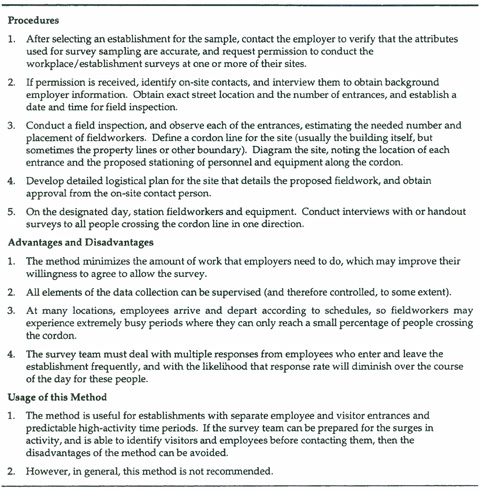
Table 18.2 Workplace/Establishment Survey Methods: The Employee Survey
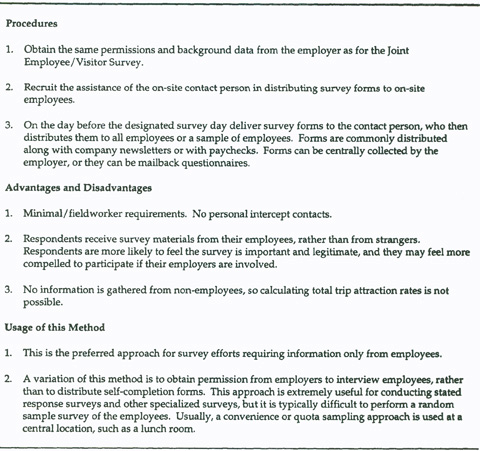
Table 18.3 Workplace/Establishment Survey Methods: Seperate Employee and Visitor Surveys
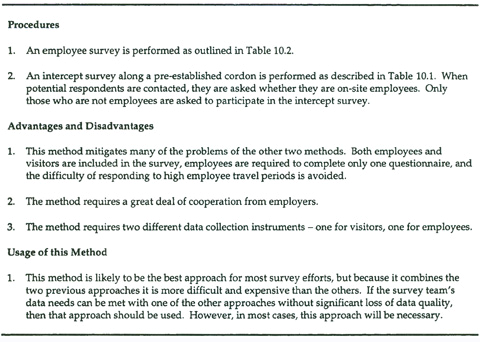
Sometimes, in special circumstances, fieldworkers alternately perform the surveying and counting functions at particular locations. For instance, for the first 15 minutes of an hour, the fieldworker interviews or distributes forms to people, then for the next 15 minutes, he or she counts people, then switches back to surveying. Provided that people arrive and/or leave the establishment randomly throughout each hour, the partial count results can be factored to the full hour, and a single fieldworker can successfully complete both assignments. However, it is generally not a good assumption that people arrive or depart randomly, and so this approach should only be used in certain situations.
Counts which are conducted in one direction are generally easier for the field personnel to keep straight. If entrance counts and surveys are used, better time of arrival data are obtained, but data on how long a respondent stays at that destination are missing (or needs to be derived from survey questions). Some businesses, generally restaurants, prefer interviews to be conducted as the patrons leave. The decision to count and/or survey only the entering or the exiting people can be made for all survey locations, with exceptions made on a case by case basis. The only rule is that ALL PERSONS MUST BE COUNTED, in order to establish the base rate of trips to or from the establishment.
The last issue related to counting is whether vehicle counts should be taken in addition to the person counts. The answer to this question will depend on the modeling needs of the survey team, on whether questions on mode of arrival and auto occupancy are asked on the survey, and on the desire of the analyst to have independent checks on survey results. Technically, with the person count data and with detailed survey data on access mode and vehicle occupancy, the survey team will be able to estimate vehicle trips to and from the site with a high degree of accuracy. Vehicle count data, however, can sometimes provide assurance that the survey is accurately capturing travel to and from the site, especially at sites with drive-through facilities, such as fast food restaurants, banks, and dry cleaners.
If several sites with independent parking facilities are to be included in the workplace/establishment survey, the use of more automatic traffic recorders may be cost-effective. Care should be taken in placing tube counters in driveways to parking facilities, however. The slow speeds and angles of approach of vehicles can impair the accuracy of the vehicle counts, and a manual verification count for two or more hours is recommended where these locational barriers are a potential problem.
Data Collection Techniques for the Workplace/Establishment Survey
If a separate employee survey is to be conducted (either by itself or as part of a employee/visitor survey), it is recommended that the survey team rely on centralized employer distribution of self-completion surveys with on-site return, rather than mailback return, where possible. Of course, if on-site return is logistically difficult or impossible, a mailback survey is the only option. Personal interviews of employees (other than when they are entering or leaving an establishment) are usually infeasible. To draw a random sample of employees requires the employer to either provide the survey team a complete list of employees with home contact information, or to provide the survey team with the opportunity to contact employees during work hours. Most employers would refuse either option.
The survey team has three data collection options for the intercept portion of the workplace/establishment survey:
- Personal distribution of self-administered survey forms;
- Personal interviews using pencil and paper methods; and
- Computer-assisted personal interviews (CAPI).
The advantages and disadvantages of self-administered surveys and personal interviews are described in Chapter 3.0. For workplace/establishment surveys, the primary tradeoff between the two methods is between the better response rates (and, therefore, lower potential for bias) of the interview method and the quicker distribution and the lower level of intrusiveness of the self-completion method.
If the survey team chooses to conduct interviews, they next need to decide whether the interviews will be recorded by conventional techniques or by CAPI techniques. As discussed in Chapter 3.0, CAPI systems have the following advantages:
- They can be designed to permit the entry of only legal codes in any particular field (prevents data entry errors).
- They can be used to check entries to make sure that they are consistent with other previously entered data (prevents data inconsistencies).
- They automatically route interviewers through the interview (ensures respondents are asked all the relevant questions and are not asked ones that should be skipped).
- They can use information from previous questions or previous interviews to make interview questions or the sequencing of questions specific to a particular respondent.
- The survey team is able to use the computer screen as a means of communicating with respondents. With CAPI, the survey team is able to present visual information to which respondents can respond, including:
- The interview questions (some types of questions, such as rating scales, can be presented graphically);
- The interview answers so that respondents can check to ensure that the interviewer is recording the proper response;
- Information commonly shown to respondents on show cards such as household income-level categories;
- Computer graphics (including video) to illustrate particular questions; and
- Geographic representations of information provided by the respondent.
However, CAPI systems also have the following disadvantages compared with standard PAPI interviews:
- A great amount of programming time and effort is needed before the survey. The CAPI program needs to be nearly perfect before the survey is fielded, because interviewers will not generally be able to fix it in the field.
- They require interviewers with more skills (or, at least, different skills).
- There are no source records for the interview. The survey team must rely on the interviewer to enter information correctly.
Accuracy-Enhancing Measures
Like other travel surveys, a potential source of bias in workplace/ establishment surveys is usually non-response, but, the issue is more difficult to deal with for the workplace/establishment surveys. Workplace survey non-response can occur at two levels, in asking employers to participate and in asking employees and visitors to complete the survey.
The first and most important step for the survey team in reducing non-response is to effectively “sell” the survey effort to the employers in the sample. It is often very difficult to persuade employers to participate in the effort. Survey teams should consider the following strategies to obtain the necessary support:
- Before contacting employers, contact local political officials and the Chamber of Commerce (or some other local business organization) to solicit support for the survey effort. Recent survey experience has shown that employers are more willing to participate in the workplace/ establishment survey if the first contact letter is sent from one of these organizations.
- Contact the most senior managers as possible at the sample firms. Even though contacting them is more challenging and time consuming than talking to mid-level managers, the senior managers may be more willing to “see the big picture,” and they should be able to provide a decisive response one way or the other immediately.
- Be prepared to provide a detailed proposal of how the survey team would like to proceed, including the survey methods, survey dates, and likely questionnaire content. Also, be ready to compromise with the proposed plan. If a manager sees that the survey team is willing to work toward an acceptable arrangement, he or she is more likely to see that the participation of the particular firm is important.
- Finally, concentrate resources on the largest firms in the sample. Large firms are far more likely to be in sampling strata with fewer establishments; so failing to obtain a large firm means losing a significant proportion of a stratum’s employees, with limited hope of substitution.117 Note that this does not mean large firms should be oversampled, but that every effort should be made to secure their participation.
The survey team faces many of the same challenges as in other intercept surveys. Since the contact takes place while the respondent is going somewhere, persuading him or her to cooperate can be difficult. In addition, unlike some surveys, nothing is known of the potential respondent prior to contacting them; it is difficult or impossible to either pre-notify them of the survey or to follow-up with them later. On the other hand, the in-person request is usually the most effective approach, and so respondents who have time will usually agree to either be interviewed or to take a self-administered questionnaire.
The most effective approach for persuading employees to complete centrally-distributed survey forms is usually to stress that their employer supports the effort and believes it to be important. This message is best sent by having the employer distribute the surveys. A cover letter explaining the survey effort from the employer to employees is usually a very effective approach for building response.
18.3 Sample Design
Workplace and establishment surveys typically employ a two-stage sample design. The first stage is a sample of non-residential businesses in the area, and the second stage is either a sample of persons arriving at the establishment or a sample of the employees at the establishment.
The first-stage sample element is the business or establishment. Once the establishment sample frame is developed from available data sources, a representative sample of establishments to survey can be drawn. The establishments are typically stratified into a relatively small number of fairly homogenous groups. Usually, the four stratification criteria are:
- Area type or location within the study area;
- Industry type (type of business);
- Number of employees; and
- Freestanding versus non-freestanding establishments.
These criteria are discussed below.
The location and/or area types of workplaces are likely to affect the number and types of trips attracted to a site. Area type is generally a surrogate measure for development density and land use form. Typically, non-work trips per employee are different in amount and type (trip length, mode) in densely developed areas than in sparsely developed areas. Trip rates per employee or per square feet vary as one moves from the CBD to the suburbs to rural areas. In addition, the available travel choices are likely to be substantially different between the different types of areas. A simple delineation of area types is to break up the study area into CBD/urban, suburban, and rural areas. Other categorizations could be based directly on densities or more subjective measures related to urban form, like the presence of sidewalks. GIS is a very useful tool for developing area types of this nature.
The area types used should be applicable to the total population of commercial establishments in the study area. The borders of the areas should be contiguous with Census Tracts, TAZs, or Municipal boundaries in order to enumerate how many total employers and employees are in each area type.
Since different types of businesses attract different types and numbers of trips, establishments are generally classified into different categories based on the North American Industrial Classification System, or NAICS codes. NAICS codes classify virtually all economic activities into a standardized set of codes, based on the type of industry or business activity. NAICS codes can be quite detailed, with up to 6 digits used. The most commonly used set of codes is probably the 3-digit level classification shown in Table 18.4. However, for purposes of travel demand modeling, some of these codes are also commonly combined into a manageable number of categories, such as Retail, Basic, Service, and Government.
The main reason for stratification by industry type is to reduce the variance in trip rates by trip type per employee within each category. Home-based work trip rates vary slightly across all business types, but other types of trips can be much different between categories. For instance, home-based shopping trips per employee in a Basic industry should be close to zero, while home-based shopping trips per employee for a Retail industry should be relatively high.
There is evidence that work trip travel behavior is affected by the size of the employer, particularly for considering the effects of TDM measures. Larger employers may be able to offer transit subsidies, carpool/vanpool matching, special parking facilities or costs, on-site daycare and/or cafeterias, and other amenities that can modify the characteristics of employee trips.
The number of employees in an establishment can range widely from very small businesses with fewer than 10 employees, to huge workplaces with a thousand employees or more. The frequency of workplaces by employment size is skewed toward the smaller businesses while the distribution of total workers is skewed toward the larger businesses. As a general rule, the largest 20 percent of the businesses in an area account for 80 percent of the employees, whereas the rest of the businesses (80 percent) employ 20 percent of the work force.
Recent work in workplace/establishment surveys has shown that there are differences in travel behavior between “freestanding” and “non-freestanding” sites.118 Freestanding sites are those which do not share facilities such as parking with other establishments. Besides the cited differences in travel behavior, the two types of sites require different survey methods since at a non-freestanding site, persons who are visiting one of the other establishments may be counted or intercepted. There is also the potential for “double-counting” persons who visit more than one site. It may be a good idea to add a question asking how many establishments were visited in the group of establishments.
Table 18.4 3-DIGIT NAICS Codes
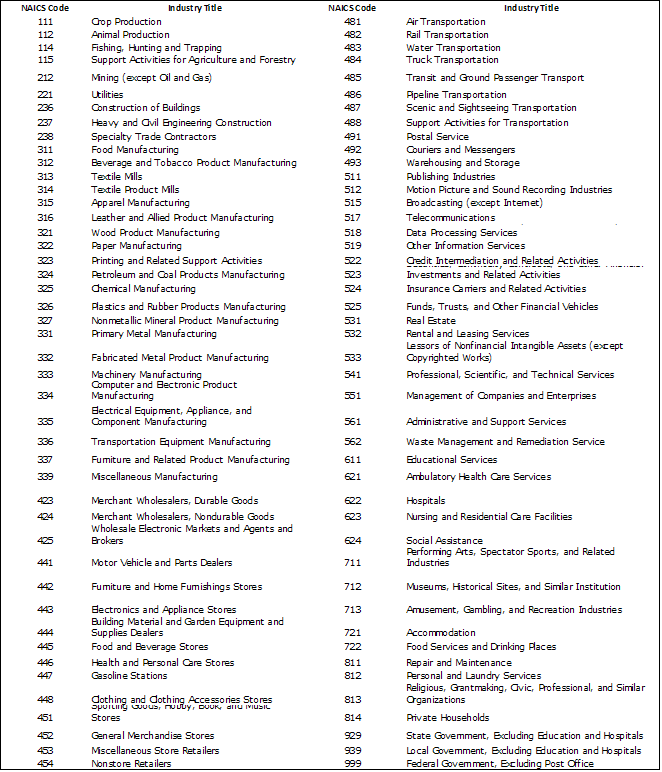
Once the establishments have been categorized, the survey team should determine the number of establishments and employees in each stratum. For some survey efforts, a random sample of establishments in each stratum will then be drawn. However, if the sampling unit is the establishment, then small employers and large employers have an equal probability of being selected – a “mom and pop” grocer with three employees has the same chance of being chosen as a 3,000-employee complex.
For most analyses, an approach that considers the number of employees is more desirable. One way to resolve the potential imbalance is to weight employee and workplace frequencies. If one were to weight them equally, then:

where:Nk = number of samples in class k;
N = total sample size;
F = total number of establishments’
Fk = total number of establishments in size class k;
E = total number of employees; and
Ek = number of employees in size class k.
For example, say that in employment class k there are 10 establishments with 1000 employees. For all classes, there are 100 establishments with 5000 employees. If a total of 20 establishments are to be surveyed, then the number of establishments in class k will be:

Another method of setting the number of samples is as a proportion of the universe.119 Briefly, these steps are:
- Determine the distribution of worksites by area type and industry type.
- Allocate the number of employees by area type and industry type.
- Calculate the average number of employees per worksite by area type and industry type.
- Compute the distribution percent of all workplaces by area type and industry type.
- Define the total sampled employees in each industry type by calculating the sample percent for employees.
- Determine the number of employees to be sampled by industry type by applying these rates to the total employment by type.
- Distribute the total sampled employees by industry across area types based on the portion found in the universe. This number of employees to be sampled by area type and industry type is the minimum desired.
- Calculate the number of worksites to be sampled by dividing this desired sample of employees by the average number of employees by site.
- The minimum number of sites in a cell should be set (for instance 10 sites), so if the number of sample sites is less than the minimum in any cell the number is adjusted. A maximum may also be set.
The recommended percent of total employees (Step 6) should take into account the variation in the amount and types of trips of employees and visitors to various activity types. For instance, the trips to a Basic establishment are accounted for primarily by the employees of that establishment, and the variation between different Basic establishments is low. The highest variation in terms of the amount of trips is in the Retail sector, where the majority of trips are from visitors. For instance, two retail establishments each have 10 employees in attendance on the survey day. One is a fast food restaurant and generates 90 trips per employee. One is a plumbing supply shop and generates 10 trips per employee. The Service sector contains some sites which are similar to Retail in terms of the number of trips generated per employee, such as a busy clinic or a DMV office, and also includes sites where the number of trips is quite low, such as a quiet office. Given these variations, the survey team set the percent of Retail and Service employees higher than that of Basic employees.
The most simple and direct method of developing the sample is to select every nth employee, and therefore the establishment in which that employee falls. For example, if there are 1,000 employees in the CBD Service sector, and a two percent sample of Service employees is desired, every 50th employee becomes the sample indicator. One would first rank order the establishments by size from largest to smallest. Then a random digit lower than the interval of 50 is chosen as the start (say 3). The 3rd employee indicates the first sampled establishment (the business in which that employee works). The second sampled establishment is the one containing the 53rd employee (3 + the interval of 50), and the third is the one containing the 103rd employee (53 + the interval of 50), etc. until 20 employers have been selected. The sum of the employees in the selected 20 (or fewer) businesses should be about two percent of the total employees.
The number of establishments that will need to be contacted in order to achieve the number of samples required is based on the survey team’s expectations about:
- The employer refusal rate;
- The employee response rate; and
- The completion (versus attempted) rate for the employee questionnaires.
In some survey designs, not every employee at larger establishments is required to complete a questionnaire: a subsample of employees would be adequate. One method to accomplish this is to give every employee a questionnaire, sort the returns by serial number, and then sample out (remove) each form that ends in a random digit(s) chosen beforehand, or every nth form. This method is simplest for the establishment to administer, but more costly for the survey team since there is a cost for printing the extra questionnaires. A second method of subsampling employees is based on employee number (if sequentially assigned). If one-third of the employees are to be sampled, three random digits can be chosen (such as 2, 5 and 6) and all employees whose employee number ends in one of the digits become a sampled employee. This method is more work for the establishment, and requires a commitment by the employer to succeed.
18.4 Drafting and Constructing the Survey Materials
In order to develop the necessary survey instruments for workplace and establishment surveys, the survey team must address the following issues:
- What data are needed from the surveys?
- How should survey questions be worded and presented?
- What survey instruments are needed, and how should they be designed?
Data Elements for the Workplace and Establishment Survey
Workplace/establishment surveys collect three broad types of data:
- Establishment information;
- Employee information; and
- Visitor information.
The survey team needs to carefully determine all of the data elements that are likely to be needed from the survey effort. Specific survey efforts will seek many of the elements described in Tables 18.5, 18.6, and 18.7, as well as other elements.
Some potential establishment data elements are shown in Table 18.5. Most of these data are typically obtained from interviews with the employer contact person. The count information must be collected by the survey team through direct observation.
Table 18.6 lists some employee data elements that can be collected with workplace/establishment surveys. In general, if the survey design relies on intercepting employees as they travel in or out of the establishment, the data elements that are sought focus on the trip being made at the time of the intercept, but if employees are contacted through a centralized means while they are at work, then questions about multiple trips or about general travel are more commonly used.
Table 18.7 shows some visitor data elements. Generally, visitors are intercepted as they travel to and from the establishment, and so visitor data tend to focus on the specific trip.
Table 18.5 Establishment Data Items
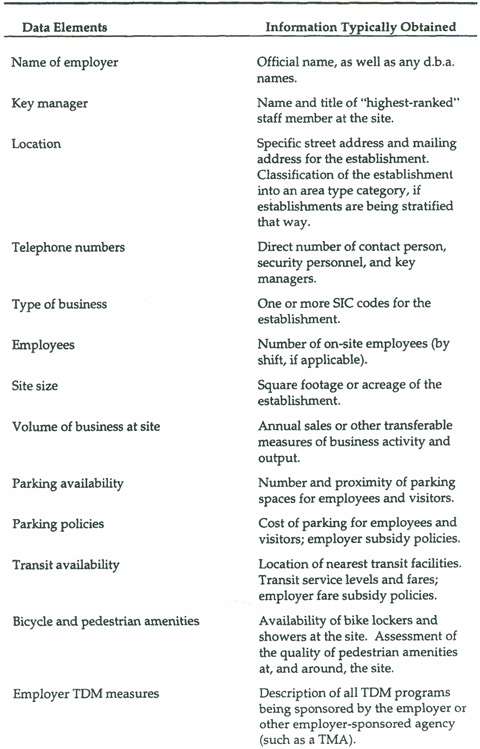
Table 18.6 Workplace and Establishment Survey Employee Data Elements
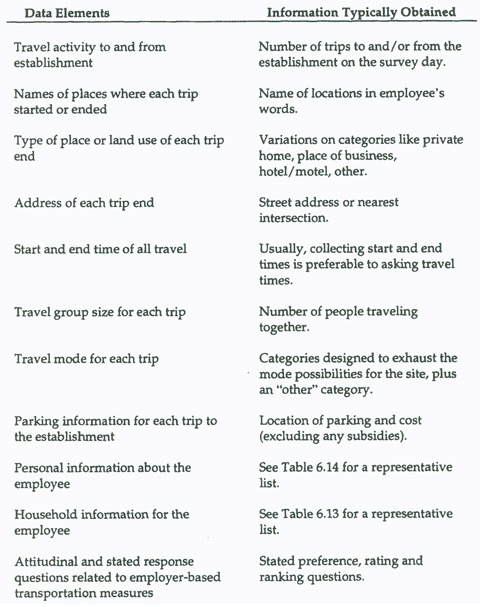
Table 18.7 Workplace and Establishment Survey Viditor Data Elements
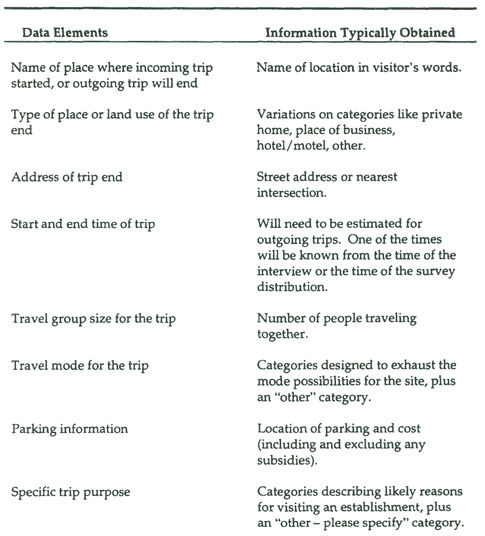
Development of Questions from the List of Needed Data Elements
Guidelines for developing survey questions from the list of data elements are provided in Chapter 8.0 of this manual.
Survey Instruments and Materials for the Workplace and Establishment Survey
Depending on the chosen survey method, the survey team could need to design and construct any of the following:
- Letters of introduction requesting permission to conduct the survey work;
- A draft cover letter for an employer’s manager to sign that would accompany the distribution of the centralized employee survey;
- An interview script for the employer contact interview;
- A self-completion employee survey;
- Collection boxes for the self-completion employee surveys;
- Control sheets for employer distributed surveys;
- Site diagram to help fieldworkers and supervisors station themselves at the establishment;
- Person and/or vehicle count forms;
- Self-completion survey forms to be distributed at the establishment cordon;
- An interview script or CAPI program for interviewing people as they cross the establishment cordon; and
- Control sheets for interviewers and fieldworkers distributing forms.
The survey team should draft a letter requesting permission from employers to conduct the survey at their establishment. As noted above, it is desirable to have the letter be sent from a third party, such as the Chamber of Commerce or the Mayor’s Office, but the survey team should produce the first draft of the letter to ensure that the survey procedures and uses are described accurately. The letter should stress the importance of the survey effort and the need to have the cooperation of the specific establishment in question. The letter should also explain the confidentiality of the survey data.
The survey team will also need to produce a draft cover letter for the employer to attach to each employee survey form. This letter should reiterate the information supplied in the permission letter, clearly indicate that the survey has been approved by the employer, and explain any special survey retrieval procedures (such as the location(s) of survey collection boxes). The letter should also identify the principal contact person for the employer, so that he or she can answer any questions about the survey effort.
Once the survey team has obtained tentative permission to conduct the survey at a particular site, the employer’s contact person or other knowledgeable staff should be interviewed about the establishment.
These interviews are commonly conducted informally as the survey arrangements are being completed, but it is much better to take a few minutes to conduct a formal or semi-formal interview with a pre-established script or questionnaire. Informal data gathering often causes interviewers to forget to ask particular questions that might be important in analysis. The survey team should consider providing the contact person with a list of questions or a discussion guide prior to the interview so that related files can be ready at the time of the interview.
The self-completion employee survey questionnaires can actually be quite detailed, because they may ask about each trip made to or from the establishment. The forms may be presented on standard size and weight paper since they may not need to be mailed back, or they can be distributed with business reply envelopes. Examples of two recent employee surveys are shown in Figures 18.1 and 18.2. If the forms are to be re-collected by the employer contact person, it is also helpful to supply one or more collection boxes with accompanying signage to ease the return process. To help the contact person with their efforts, it is also helpful to provide written instructions and to ask them to record their progress on a control form. The instructions and log form for a recent Illinois survey are shown in Figure 18.3.
When one or more survey team members visit the establishment prior to the survey, a site plan should be obtained or developed. This plan should show the proposed cordon and all potential exits. In addition, the plan should note any special circumstances and survey design issues. For instance, the site plan should include the fact that certain exits are not available at certain times of the day. Often a common site plan form, such as that shown in Figure 18.4, is used by survey team members to record the site information.
Because counting people entering or leaving an establishment is usually an integral part of the survey effort, standard count forms should be used to record the information. An example form is shown in Figure 18.5. Usually, the counts are collected on an hourly basis. If hand-held tabulators are used, it is suggested that the counters not turn them back to zero each hour, but let the daily total run, and simply record the current total at the beginning of the hour.
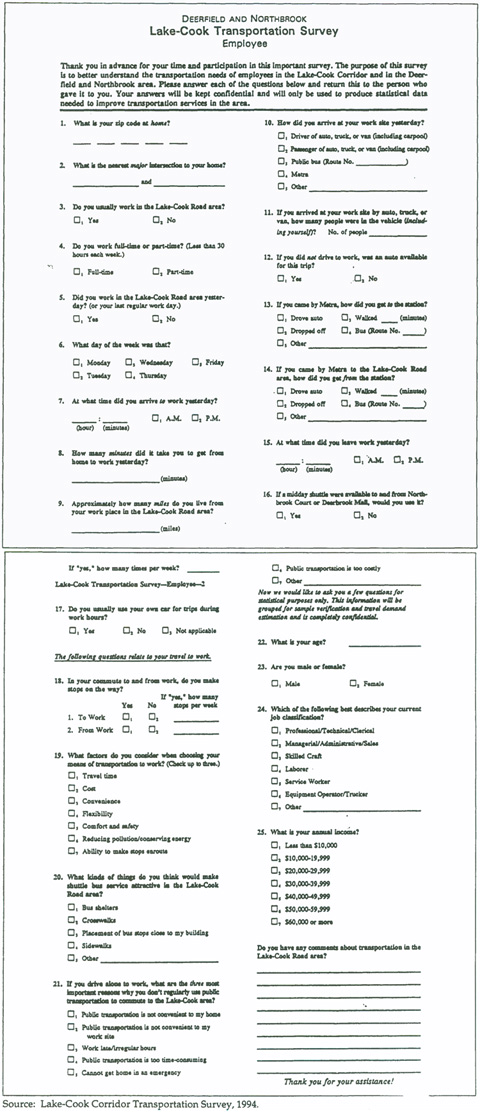
Figure 18.1 The Lake-Cook Corridor Employee Transportation Survey
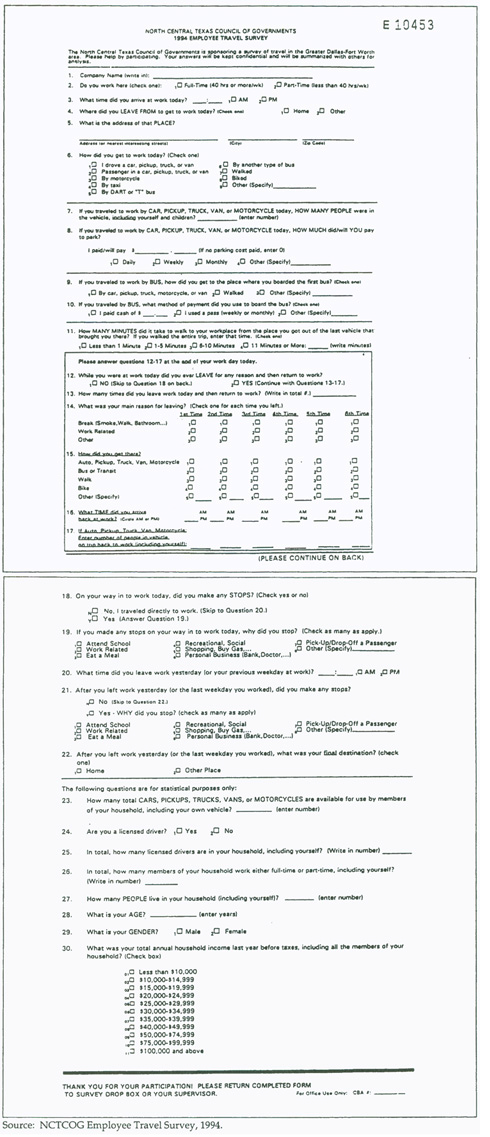
Figure 18.2 The NCTCOG 1994 Employee Travel Survey
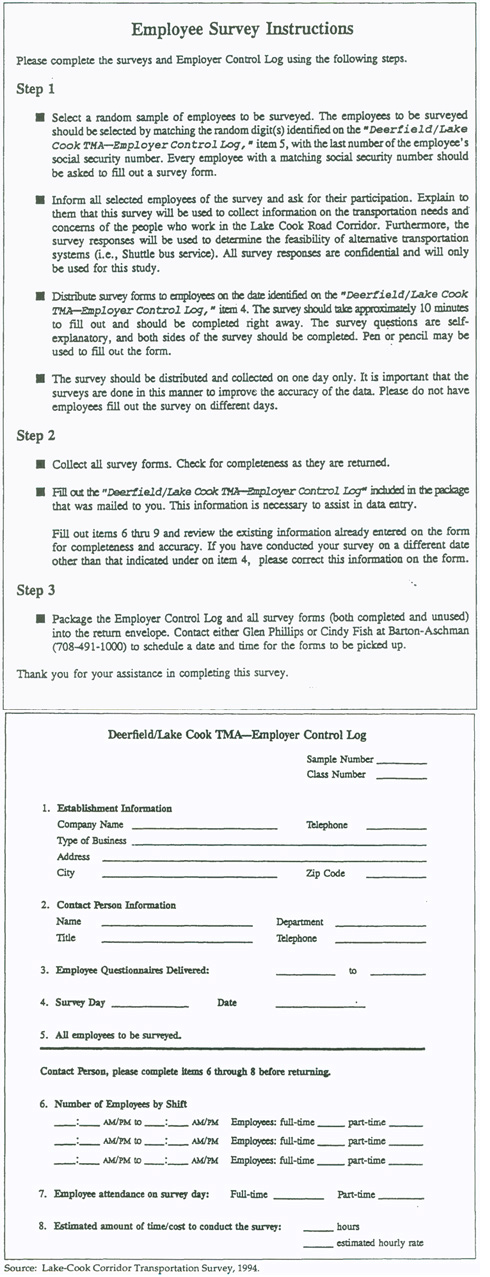
Figure 18.3 Employee Contact Person Instructions and Control Log for the Lake-Cook Transportation Survey
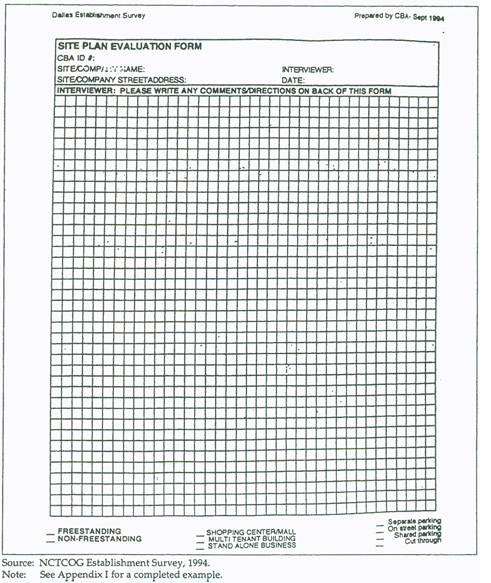
Figure 18.4 An Example Site plan Evaluation Form
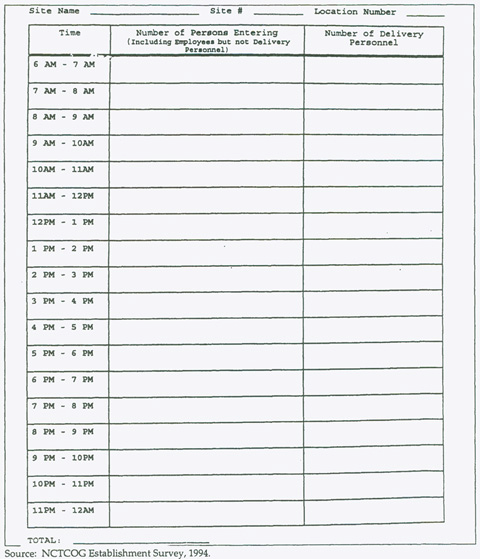
Figure 18.5 Example Person Count Form
The visitor survey instrument may be either an interview script or a self-completion questionnaire. If the self-completion approach is used, the survey forms are likely to be shortened forms of the employee survey forms. The interview scripts, whether pencil and paper or CAPI, should be designed to be administered quickly and with minimal perceived effort by the fieldworker. An example interview form is shown in Figure 18.6. This form actually allows the interviewer to record two interviews on one form in order to reduce the number of forms that they will need to complete. Both interviewers and fieldworkers distributing self-completion questionnaires are also usually asked to complete simple control logs on an hourly basis.
Pretesting
A pretest of the developed forms and procedures should be conducted on several sites in various area types and industry types. No matter how straightforward the forms or procedures, the pretest invariably surfaces one or more problems or constraints that were overlooked, from a typographical error on the forms to low response rates for one or more industry types. Knowing the potential problems before full-scale fieldwork begins is invaluable, and can avoid insurmountable difficulties or bad data later in the survey process.
In a pretest, generally several sites are recruited, surveyed, and analyzed. Personnel involved in the pretest should include the survey planners and field staff who are slated to become field supervisors during actual fieldwork, but where possible, actual fieldworkers should be used for the pretest. Personally going through the procedures allows the field supervisors and fieldworkers a greater understanding of the strengths and weaknesses of the survey design. Depending on the complexity of the survey, the number of sites could be from five to 30. Sufficient employee and visitor returns should be recovered to make estimates of the validity of the data, usually at least 30 to 50 returns of each.
Each question is typically analyzed with one of three outcomes: valid, invalid, or blank. A valid response means that the respondent understood the question and gave a logical response within the data range expected. An invalid response means the respondent did not understand the question or gave an illogical response outside of the expected range. For example, an invalid response often arises when a question on mode of access to transit is worded “If you used transit,...,” but individuals whose mode was auto answer the question. An out-of-range example is a written answer of 600 for the number of minutes traveled to the worksite. A blank response is self-explanatory, and often arises as a non-response in demographic questions (age/sex/income). One would expect a non-response rate of over 10 percent for an income question, but if the questionnaire is eliciting item non-response of more than five percent on any other questions, the survey team should check the wording, font size, and placement on the form to see if response can be improved.

Figure 18.6 The NCTCOG Viditor Travel Survey Interview Form
Once the pretest forms have been analyzed and corrected, the procedures should be examined. The surveyors, counters, and supervisors should be debriefed on the procedures to ensure that each member of the survey team understood and followed the correct guidelines. Individual surveyor’s interview sheets and control forms should be analyzed to uncover any coding problems before fieldwork begins. Often, the surveyors need to be reminded to get full and complete geographic detail for the origin information. Changes to the procedures should be documented carefully. If procedures are modified to a great extent, it is a good idea to pretest the new procedures before going into the field with the final survey.18.5 Training and Briefing Survey Personnel
After the survey pretest, the surveyors should be trained in the fieldwork procedures. A Manual of Procedures should be prepared that will describe to each surveyor the method for conducting the intercept surveys, and a formal training session should be required of each fieldworker. The training session should cover the following issues:120
- Overview – This is information on the nature of the study - why it is being undertaken, how the findings can be used, and its important implications that may benefit the people or the problem under study. This information is useful to motivate interviewers, and to allow fieldworkers to address respondents’ questions.
- The Sponsor – Fieldworkers should understand the survey sponsorship so they can provide respondents with the correct answer. In government sponsored research the sponsorship is not kept secret, as is more common in commercial marketing research.
- The Population – Training should describe the people being studied (such as whether visitors and employees, or only visitors) so that fieldworkers know whom they should be talking to.
- Survey Methodology – If fieldworkers are inexperienced, the training session and manuals should introduce fieldworkers to some of the theory and practice of survey research. This is especially useful for fieldworkers who are challenged by potential respondents to justify the survey process.
- Sampling – Fieldworkers also must know enough about sampling to understand the principles of randomness and the sources of sampling biases.
- Consistency (standardization) – Training must convince fieldworkers of the importance of standardized behavior in the workplace/establishment surveys. Fieldworkers must understand the reasons for consistency in approaching respondents, introducing the study, asking questions, and recording responses.
- Interviewer Biases – A large part of the training sessions should be devoted to showing fieldworkers how their own personality and characteristics can bias questionnaire data. They should learn to identify the major sources of interviewing biases, both generally and for themselves specifically, and should be made aware of the devices for protecting against their own behavior influencing respondents’ answers.
- Respondent Biases – Training should deal with respondent motives for not participating in survey efforts, and for evading or falsifying interview responses.
- Selection Procedures – Trainers should demonstrate how to read building layouts so fieldworkers can properly position themselves. In addition, fieldworkers should be taught how to select individuals for the survey. Often, this is most easily conveyed by actually simulating the field conditions.
- Interviewing or Questionnaire Distribution Procedures – The training session should show respondents how to administer the questionnaire (either by conducting an interview or by distributing a self-administered form), and how to record the respondent contacts or serial numbers on quota sheets or time logs. Role playing during training is invaluable in surfacing any misunderstanding about the questions or procedures.
- Supervision and Problem Solving – This is straightforward information about who supervises the fieldwork, which supervisors work with which fieldworkers, what their responsibilities are, why supervisors are required to carry out checking and monitoring activities, and so on. The intention is to improve fieldworkers’ understanding of the managerial role of the supervisor in coordinating the survey effort, and to encourage fieldworkers to seek assistance from supervisors, rather than hide their problems. The supervisors can conduct the role playing sessions in small groups of five to 10 surveyors to assert the supervisors authority and to open the channels of communication.
- Verification – Without implying distrust, the training session should address the criteria and procedures that will be used for verifying interviewers’ work, including recontacting respondents, supervision, debriefing, and data and records analysis.
- Scheduling and Logistics – At the training session, fieldworkers should be told of the time and timing of the survey, the number of forms to be distributed or interviews to be conducted, the assignment locations, procedures for getting assistance, and the use of field instructions and other materials and forms.
- Administrative Procedures – In some cases, the training session may need to be used for detailing fieldworkers’ conditions of employment, including wages, tax withholding, benefits, insurance, dates of payment, etc.
Appendix I provides a recent Survey Fieldwork Manual that was developed for establishment surveys in the Dallas-Fort Worth area.
18.6 Conducting the Survey
General Procedures
Once the sample of workplaces has been determined, the actual survey procedures can be implemented. The following procedures are usually followed when employee and visitor data are obtained separately.
- Call each sampled establishment to determine if the establishment is still in operation, verify the address and get the CEO/owner/ manager’s name and title. A brief explanation, if any at all, is all that is needed for this call.
- Send a recruiting letter to each sampled business. This first contact letter should have a number that the business owner can call to verify that the survey is legitimate.
- Interview/recruit employer and establish contact person. The first recruiting call should be made two to three weeks after an individually addressed and personally signed letter has been sent. The CEO/ owner/manager is the first contact to garner the businesses’ participation. When contact is made with him or her, the importance of that businesses’ participation in the survey will be explained as well as the procedures; agreement to participate will be obtained. Generally, a contact person will be designated to assist in distribution and pick-up of the employee questionnaires; this person is often an administrator, human resources, or secretarial staff person. A full explanation of the procedures during the recruitment call – the employee survey, the visitor survey, the counts and the employer information required – helps reduce late drop-outs which waste resources and time.
Determine number of employees, hours of operation and hours that counters may have to be in place, exact street location, square footage, and number of entrances. Conduct as much of the employer information interview as is feasible to allow the site to be properly scheduled. Keep track of the outcome of each call in the employer contact log.
- Schedule the survey day. If the sample consists of many sites, or the survey is to be conducted over a long period of time, scheduling of sites should take into account the geographic proximity of sites scheduled for the same day. Plotting the sampled sites using a GIS, and recruiting and scheduling sites in the same area for the same day saves on oversight and supervisory time, and allows surveyors and counters to carpool even though they may work at separate sites. If the sites are close together, one supervisor can manage oversight and relief of three to five sites (depending on the size and complexity). The survey day is tentative until the site visit is complete, and any special qualities of a particular site are understood.
- Schedule a personal site visit. Set up a time for a personal visit, for field inspection, and to deliver employee questionnaires (one or two days to a week or more before survey day). A personal visit to the employer to drop off questionnaires and conduct the interview makes a large positive difference in completion rates for each establishment. It is recommended personal visits be used at least for the larger establishments.
During the personal visit, conduct field inspection and observe the number of entrances, estimate the number of visitor surveyors required, and the number and placement of counters. Define a cordon around the establishment. It is always a good idea to check the site plan with the contact person before completing the survey design to ensure that all doors are noted and covered by counters, and that a door that is not operational is not scheduled to be counted. In larger buildings and more secure sites, a copy of the site plan with surveyor/counter positions shown should be left with the security or personnel director. The scheduled survey day can be confirmed unless peculiarities of the site require rescheduling.
- On the designated survey day, station surveyors should remind the contact person to deliver employee questionnaires. Counters should be in place 15 minutes before the first person arrives on the site, and surveyors placed 15 minutes before the scheduled business hours begin. The site supervisor is responsible for complying with the instructions and placement shown on the site diagram.
- Count commercial vehicles going to the establishment during working hours on the survey day. The delivery personnel may be surveyed as visitors, or may be surveyed separately (if at all – delivery persons generally are rushed and often refuse to be interviewed or fill out a questionnaire).
The purpose of the personal visit to the site, although resource intensive, is threefold: to provide the employee questionnaires to the employer; to complete the data needed on the employer and to answer any remaining questions the employer may have; and to review the survey site. While the first two could be accomplished by telephone and mailout/mailback of questionnaires, experience has shown that a personal visit to each site has a positive impact on completion rates. A site visit, however, to review the site and develop a strategy is necessary.
The Site Strategy
Review of the survey site consists of two parts:
- Externally touring the site and diagramming the layout of the buildings, the locations of parking, and the locations of driveways and doorways; and
- Interviewing the senior person or contact person.
For more complex sites, the site review consists of a third component: internally touring the building(s), and externally retouring the site. The reason for sometimes undertaking such an elaborate site review procedure is to develop a survey strategy. Just as there is no standardized company layout or business operating practice, there is no clean and neat survey strategy that can be applied equally well to all surveyed establishments. Each establishment has its own peculiarities that will affect the way counts are conducted and how visitors are intercepted. Thus a strategy should be developed during the course of the inspection of the site, based on the specifics of the site and its operations.
To obtain a true count, it is absolutely essential to station the survey personnel in the proper locations. The fieldworkers assigned to count entering and exiting people are generally instructed only to count, not to make decisions or judgments about what people were actually doing or why they were making a trip. Interviewers obtain that information on a sample basis. The accuracy of the counts therefore depends almost entirely on the soundness of the strategy for stationing survey personnel. Counting only entrances to the establishment requires excluding from the count the traffic that was internal to the operation, e.g., trips between offices/departments within the establishment or trips to the restrooms and lunchrooms. Excluding internal traffic from the count generally requires developing establishment cordons at the outer boundaries of the site.
Isolating trips to the surveyed establishment sometimes requires distinguishing between trips to the surveyed business and trips to other businesses. Some sample establishments will adjoin or share space with other establishments that are not being surveyed. To reduce the possibility of mistakenly counting trips to other businesses, the survey planner may wish to establish count stations as close as possible to the activity center(s) of the surveyed business and away from the outer boundaries. This would focus the count on the surveyed business only.
These contrasting approaches are suited to different building layouts and modes of operation. For many of the surveyed establishments, the correct strategy can be determined only after interviewing the employer and touring the site.
Car dealerships are a prime example of the potential problem of counting internal traffic. The area of activity extends beyond the walls of the showroom to include the adjacent car lots. Salespersons come and go between the buildings and the lots many times each day, but it is all in the course of their work on the site. In order to avoid falsely counting this internal traffic as trips to the establishment, an outer cordon approach can be used. With this method, inbound trips are counted at the driveways leading into the site rather than at the doorways leading into the buildings on the site. These counts can be vehicle counts, and the person-trip equivalents estimated from the survey data, or for consistency with other sites the counters can count persons entering in vehicles.
This method is clean and efficient but will yield an accurate count only under certain conditions. The driveways must be used only by persons going to the surveyed establishment (a strip shopping center would almost never qualify, for example). Also, all traffic to the surveyed establishment must use the driveways into the site. If some trips to the site use a parking lot outside of the cordon area, or do not arrive by auto, then those persons entering on foot need to be accounted for. In that case, survey personnel need to count persons in cars at driveways and also count persons on foot entering at locations other than at the driveways.
For many establishments, a large amount of the person traffic in and out of the building is made up of employees taking short breaks. The prevalence of the smoke-free workplace complicates the counting of persons entering the site by creating a greater incidence of employee trips. The survey team has three options for properly accounting for employee break trips, like smoking trips. The first possibility is to determine during the employer interview if the establishment provides an internal smoking area and if all smokers use it. If the answers to both were yes, then the smoking trips would never be observed and, therefore, never counted. The second possibility is to conduct the cordon count, outside of where employees are likely to take their breaks, in which case the smoking trips would not be counted. The third possibility is to specifically ask employees on the employee questionnaire the number of times they left the building for incidental trips such as smoking.
The incidental trips will ultimately be subtracted out of the total count on the basis of responses on the employee questionnaires. It is recommended that incidental trips be accounted for on the employee questionnaire, since so many buildings are smoke-free and cordon counts cannot be guaranteed at each site, but the survey team needs to remember the difficulty of getting respondents to remember short, incidental trips.
Five special reminders:
- Trips made by the employee in and out of the worksite must be accounted for on the employee form.
- Incidental trips, such as leaving the building to smoke, must be accounted for as well.
- Every door through which a person may enter MUST BE COUNTED. Contact the security personnel if the door is locked during the site visit to verify that the door in question is never opened.
- Have the same wording on questions that will allow comparison with the Household Travel Survey, such as the same income ranges, auto ownership, and employment status definitions.
- Be sure to contact all agencies which will be involved in participation, such as security personnel, building management, all building tenants, etc.
The visitor survey will be undertaken by survey staff at the entrances of each establishment on the scheduled survey day. The counters and surveyors are generally placed at their stations 15 minutes before the first person arrives, which is often much earlier than the posted business hours for a site. The times for placing the counters should be discussed with the contact person. Each entering person, or if a subsample approach is taken each nth person, will be asked if they are visitors to the site, and if they are, they will be handed a questionnaire. If an interview technique is used, every person is approached and the completed interviews are subsampled in the editing phase. For counts that include only entrants, the field personnel will stay on-site until 15 minutes after the posted close of business.
Delivery trucks and taxis arriving at the sample establishments may also be counted by survey staff to estimate truck trip attractions. These counts are generally performed by the hour, similar to the person counts. Entering trucks may be classified by counting the axles, or by a silhouette form as shown for the commercial vehicle surveys. The classification of these vehicles should be consistent with classification counts taken on the roadways in the same time period or DMV classification of vehicles by type.
18.7 Editing and Cleaning the Data
When a survey at a particular site is complete, the returned visitor and employee questionnaires, employer information sheet, and person and truck count sheets should be edited as soon as possible. This ensures that each site supervisor and each surveyor is using proper procedures, and missing forms can still be located or information that was not filled in (such as attendance) still obtained with a phone call. The day after the survey day the site envelope should be opened and the employer information sheet edited for completeness. The number of entering persons should be totaled for the survey period and entered on the employer information sheet.
An accuracy check to verify the counts if they seem low or high is to double the entrance count and divide by the number of employees at the site. This person trip rate would be comparable to the ITE Trip Generation person trip rate for the same size and type of industry. General ranges can be established as the survey progresses to check these rates by the locally collected data. For instance, the first fast food restaurant in the survey might be checked against ITE, but the fifth can be checked against the first four. This reasonableness check is vital to ensure that the counts for each sampled site are accurate.
Once the editor is satisfied that the employer and count information is complete, the questionnaires returned by employees and the questionnaires or interviews of visitors are examined. Refusals and blanks can be discarded, and the completed questionnaires sent to data entry. Not every questionnaire will have every question answered, and rules to identify a completed questionnaire should be determined in the survey design and given to the editors. Generally, whether the employee or visitor came from home, the mode, and whether employee trips were made during working hours are used as the primary pieces of data. The critical questions that define a completed questionnaire should be identified during the survey design phase.
After each employee questionnaire and each visitor interview or questionnaire is edited for completeness, the number of completes should be tallied for each site on a master control log. This acts as a control log for data entry.
Cleaning the data once it is entered into computer files begins with range checks. For example, if the possible answers to a question are numbered 1-4 and non-response is coded as 99, all answers between 4 and 99 must be erroneous. In addition, certain cross checks must be performed to verify the accuracy of the data. If the employee was an auto passenger then the auto occupancy cannot be less than two. If the employee responded that the mode to work was auto, but also checked a fare type for transit trip, then the questionnaire should be examined to determine if the employee took an auto or transit.
18.8 Data Expansion
The factoring of the visitor and employee data to represent the total person arrivals at the establishment is accomplished by expanding the survey sample to equal the arrival counts. The derivation of these expansion factors follows:
C = Cw + Cnw (1)
That is, total person trip arrivals is equal to the sum of arrivals by employees (Cw) and arrivals by non-employees (Cnw). Cw and Cnw can not be counted separately and are therefore not known. However, attendance (A) is known so that the expansion factor (Fw) for employee questionnaires can be calculated from the attendance and the number of completed employee questionnaires (Qw):
Fw = A/Qw (2)
Now, an employee may enter the building once, twice, or three or more times. Each time he or she will be counted. The number of trips to an establishment by worker i is equal to one plus the number of additional trips made by the employee to the establishment during the day (K). That is, it is the sum of first trip to work plus subsequent trips by employee throughout the day. Since that information is only known for those employees who filled out a questionnaire, the sample sum must be multiplied by the expansion factor for employees, Fw, to estimate the total arrivals by employees:
 (3)
(3)
Where Ki is the number of return trips to an establishment for the employee of an establishment. Now one can obtain the number of arrivals of visitors at the establishment:
Cnw = C – Cw (4)
The expansion factor for non-employee questionnaires (Fnw) can be completed given the number of completed visitor surveys (Qnw):
Fnw = Cnw/Qnw (5)
This description of the establishment survey factoring process underscores the importance of an accurate count of arrivals at the establishment, and the necessity of obtaining the attendance of employees at the establishment. If the trips made by employees during working hours were recorded by time-of-day, it would be possible to calculate expansion factors by time-of-day exactly. If they are not, temporal assumptions regarding these trips will have to be made in order to obtain time-of-day factors.
The trip numerator of the attraction rate will be the number of employees (or attendance if attendance is to be forecast instead of employment). There may be a tendency on the part of the workplace person designated to complete the form to be somewhat casual in reporting employment. It is imperative that the data on number of employees and the number of employees in attendance on the day of the survey be as accurate as possible. It is awkward to have more employee interviews than workers in attendance for a workplace.
The final conversion to an attraction rate requires nothing more than the division of trip arrivals by the actual employment. For example, the rate of non-work arrivals per worker, a major independent forecast variable for future trip attraction predictions, is the rate of non-work arrivals to total employment.
For example, say that an establishment has 500 employees attending work on the survey day, and 250 completed surveys were obtained. Assume that these 250 surveys showed a total of 125 additional trips by employees (0.5 per employee). There were 50 completed visitor surveys, and the count showed 1000 arrivals.
Then:
Fw = 500/250 = 2.0
Cw = (2.0)(375) = 375
Cnw = 1000-750 = 250
Fnw = 250/50 = 5.0
So the expansion factor for employee surveys would be 2.0, and the factor for visitor surveys 5.0.
References
Hunt, J.D. and Stefan, K.J. and Brownlee, A.T. (2006) Establishment-Based Survey of Urban Commercial Vehicle Movements in Alberta, Canada. Journal of the Transportation Research Board, No. 1957, pp. 75-83. Transportation Research Board , Washington, DC, 2006
Census Bureau (2007) North American Industry Classification System (NAICS) http://www.census.gov/eos/www/naics/index.html
These data are available in an on-line lookup system at: http://censtats.census.gov/cbpnaic/cbpnaic.shtml. Starting in 1998, the data are classified by NAICS. However, 1994 to 1997 data were classified by SIC (Standard Industrial Classification).,